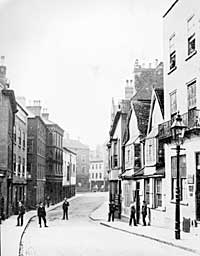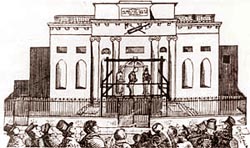THE WEEKDAY MARKET WELL.

View of Weekday Cross from High Pavement, c. 1890. The Guild (Town) Hall is on the left in the centre of the photograph.
Among the common wells of old Nottingham, numbering more than a dozen, was the Weekday Market Well." This was located on the south-west corner of the market, near the Guild Hall. The site is occupied by a pillar post-box near the S.E. corner of Holland & Webb's warehouse. On this site, over the well, was a pump which was near a greengrocer's little shop until it was demolished, about which more later.
The Corporation Records contain many references to these wells, generally and specifically, during the sixteenth and seventeenth centuries. In 1575-6 the constables reported at the sessions that "ye comen well at ye Weke Daye Cross be in dyecaye for want of repration."
They further reported that "we have presente manye tymys and no amendment." Two years later the Mickle-torn Jury reported that "the common well att Wyckeday Crosse, and the common well at Sente Marie Church yarde" were "in dekey for lacke of mendyng." In 1578 the Chamberlains paid twenty pence "for mendyng of the turnyll (or windlass) of the welle at Wekeday Crosse." F'ive shillings and sixpence was the amount expended "for mendinge the well at Weekeday Crosse, and lead and sauder."'
THE MARKET PUMP.
This interesting item is extracted from the Minute Book of the Common Council, for February, 1633-4:—
"Weekeday-cross: for ye pumpe. This Companie having heard the Mocians of the inhabitants aboute the Weeke-day cross, touchinge a pumpe to be made where the leadon well nowe stands, they are of oppynion, thatt one cannott conveniently be made to hould longe, or to be kepte sweete: therefor doe not allowe of theire Mocion, butt are content thatt the well shalbe sufficiently repayred by the newe Chamberlaynes, butt nott otherwise to be alltered."
In 1731 the Common Council issued this notice:—
"Pump at Weekday Cross.—Leave is hereby given to the neighbourhood about the Weekday Cross that they may at their own Charge Set down a Pump in the Leaden Well there and thie Corporation towards effecting the same do hereby give to the said neighbourhood the Frame of the said Well and other materiall about the same So as they fix a pump in the said Well and maintain the same for 21 years, from this day (July 26th, 1731), and otherwise the Corporation shall have the said Frame Lead and other Material again."
Two years later (in 1733) the Chamberlains were instructed to "sell the Materialls of the Leaden WeIl, and Cover the Well securely by a good arch out of the money arising of it."
In 1782, a pump was made available here. Upon it was screwed an oval brass plate, measuring 81/2in. broad by 63/4in. deep. Upon this was engraved the following words:—"Erected For Public Use MDCCLXXXII. Iohn Carruthers, Esqr Mayor Iohn Fellows Junr John Hancock Sheriffs." This pump was demolished in 1878. Through the instrumentality of Mr. George Fellows, J.P., Honorary Secretary of the Thoroton Society, and cousin of the lender, this plate, mounted on an oval oak plaque was exhibited to the members who attended the meeting on November 13th, 1917. On the back of this tablet was a soiled and partly illegible paper label on which was written the following:—"Nottingham 1878. This brass plate was given to me by the Town Surveyor, when the Pump to which it was attached on the Middle Pavement was taken down. The Pump was erected to counteract (? if correct) the intoxicating effects of the Michaelmas (or Goose) Fair. John Fellows, Junr., was my Father's Father.—Charles Francis Fellows."
Some of us well remember this pump, which stood close by a greengrocer's shop, near the Middle Pavement corner.
FLOGGING AT THE CART-TAIL.
During the extended period when public flagellation was a regular mode of punishment for both males and females, the Cross was frequently a starting place, owing to its close proximity to the police court at the Guild Hall. The offenders (and victims of this brutal mode of punishment), were tied to the tails of carts, stripped to the waist in all cases, and whipped during the journey, from one point to another. The crimes thus treated were thefts, assaults on females, immorality, &c.2 Here are two typical instances so far as flogging relates to our area:—
On 12th January 1770, a young woman detected stealing at a draper's shop, was on this market-day "fastened to a cart, and whipped all the way from the Week-day Cross to the Malt Cross, in the Market Place: three months later, a man for theft was whipped in the same manner from Weekday Cross to the Malt Cross, and thence to the Hen Cross where he was liberated, a sadder and sorer man than before he started on his ignominious journey." The degrading practice of public whipping in Nottingham was observed until 1830.3
EXECUTION TRAGEDIES.
 Public hanging outside Shire Hall in 1833.
Public hanging outside Shire Hall in 1833.To the younger generations, aged people related some of the incidents which were attendant upon a public execution at the County Hall. William Saville had been hanged on 8th August, 1844, for the murder of his wife and three children, in Colwick Wood, on 21st May, 1844. The crowd was immense. Immediately after the man had been launched into eternity, the crowd broke up in great disorder. Twelve people were killed and more than a hundred severely injured. As Button says:— "heaps of victims were thrown down and trampled upon on the Pavement, and then the pent-up tide found an outlet at Garner's Hill, down which it rolled with destructive velocity. Some fell in their involuntary descent of the steps, others became entangled with them and overthrown, and in a few seconds the steep and narrow thoroughfare was completely choked up. There the struggling mass lay—men, women, and children— promiscuously heaped together, and each moment receiving additions to its number. The shrieks of the female sufferers were fearful but not protracted, for a brief interval brought on either insensibility or the silence of death. Seldom has the eye beheld a sadder spectacle. The mass were literally writhing with agony. Groans, mingled with hurried prayers and curses, resounded on every side."
CHAPEL, 14th CENTURY.
In the possession of the Nottingham Corporation is a lease, dated May 7th, 1375, from which we gather that there existed at that time a chapel in the Forum Cotidianum or Daily Market. This was situated opposite a tavern lying under a tenement belonging to Hugh le Spicer and William, his son, and by them "granted and at ferm demised to Thomas le Taverner of Nottingham for ten years."
(1) The "Common Wells of the town
during several centuries, were located at or near Chapel Bar, Cow Lane,
Goose Gate, Narrow Marsh, St. Mary's Gate, St. Ann's, St. Nicholas', Church
Stile, St. Peter's Church, the Shambles, Spice Chamber (Exchange), Warser
Gate and Weekday Cross." There is mention of those in the printed
town records.
(2) Edward Ash was a constable wlio was in favour,
being a general utility man. In 1745, he was paid five shillings ''for
extraordinary service";
and at various times he was recompensed for doing odd jobs. He superintended the
public flagellations; for instance he received two shillings on 14th
July, 1753. Here is a copy of "Edward Ashes Bell, for whipping Sarah
Belsher, publicly, March 8th, 1757:—
| Allowed to Edward Ash | ... | 3 0 |
| " to the Whipper | ... | 2 6 |
| " to 2 Constables | ... | 2 0 |
| 7 6" |
It might be added that the form
of sentence was, that the offender "be
stripped naked from his or her waist upwards, and whipt by the Constable
until his or her body be bloody." Sometimes culprits were whipped
at the door of the prison.
(3) 6th April, 1808, was the last occasion on
which anyone was exposed to public ridicule in a pillory, in Nottingham.
This defiler of children,
named Calvin, was, after conviction, escorted from the Town Gaol to the
Market Place. Having ascended the slope of the pillory, which was situated
near the south-west corner of the Exchange, the fellow impudently bowed
to the immense crowd assembled, and was "affixed with his head and
arms in the Pillory." He did not evince any sense of shame at his
condition. After an hour's exposure he was released, placed in the cart
which conveyed him to the pillory, and was driven back to Gaol to undergo
the remainder of his sentence. There had been no similar public punishment
for upwards of sixty years.
